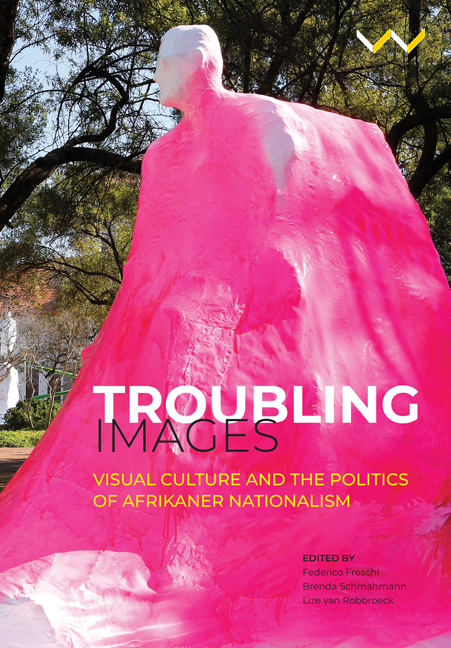Book contents
- Frontmatter
- Contents
- Acknowledgements
- List of Illustrations
- Troubling Images: An Introduction
- 1 The Trajectory and Dynamics of Afrikaner Nationalism in the Twentieth Century: An Overview
- One Assent and Dissent Through Fine Art and Architecture
- Two Sculptures on University Campuses
- Three Photography, Identity and Nationhood
- Four Deploying Mass Media and Popular Visual Culture
- Contributor Biographies
- Index
7 - Celebrating the Volk: The 1949 Inauguration of the Voortrekker Monument in State Information Office Photographs
Published online by Cambridge University Press: 21 March 2020
- Frontmatter
- Contents
- Acknowledgements
- List of Illustrations
- Troubling Images: An Introduction
- 1 The Trajectory and Dynamics of Afrikaner Nationalism in the Twentieth Century: An Overview
- One Assent and Dissent Through Fine Art and Architecture
- Two Sculptures on University Campuses
- Three Photography, Identity and Nationhood
- Four Deploying Mass Media and Popular Visual Culture
- Contributor Biographies
- Index
Summary
In the mythology of the Afrikaner nationalism of the first half of the twentieth century, the narrative of the Great Trek played a pivotal role (Thompson 1985, 180). The heroisation of the emigration of the Voortrekkers from the British-ruled Cape Colony to the allegedly empty hinterland becomes most evident in the Voortrekker Monument in Pretoria/Tshwane. When the Monument,1 the ‘national shrine of the Afrikaner[s]’ (Moerdijk n.d. (a), 37), was solemnly inaugurated on 16 December 1949, the celebrations attracted a crowd of 250 000 people (Botha n.d., 75). Prime Minister Daniel François Malan (1950, 1) proudly declared that this was ‘presumably the greatest [assembly] that has ever gathered on South African soil’.
The idea of constructing the Monument originated in 1931 and it initially was planned to be completed for the centenary celebrations of the Great Trek in 1938. But problems of financing, the process of making a decision about an appropriate site, and the outbreak of World War II caused a delay in completing the Monument (Crampton 2001, 224–226; Delmont 1992, 2–4; Jansen n.d., 24–25). While the foundation stone was laid as part of the so-called Tweede Trek [Second Trek] in 1938, the inauguration had to be postponed to 1949. This played right into the hands of Malan's National Party government, which had come into power only shortly before in 1948.
While monuments and festivals may differ in the sense that the former are mostly made from durable materials and the latter are ephemeral, they share the ability to express national values and to construct histories. The long-lasting architectures are built for the same reasons as the short-lived events are organised: to present achievements, to commemorate important historic events, to honour eminent personalities and to celebrate culture. In this way, they articulate ideologies of the socio-political context from which they originate. This ability in turn makes them amenable to propagandistic purposes. While being moulded through, and responding to, existing identities, they also shape new ones – a process involving separation from or exclusion of (opposing) groups who do not identify with the monument or festival (Crampton 2001, 222–223; Deile 2004, 7–8; Marschall 2010, 102–103). As a combination of monument and festival, the solemn inauguration of the Voortrekker Monument therefore offered the new government a unique opportunity to articulate ideas about white supremacy and to celebrate the volk – the Afrikaner people.
- Type
- Chapter
- Information
- Troubling ImagesVisual Culture and the Politics of Afrikaner Nationalism, pp. 169 - 193Publisher: Wits University PressPrint publication year: 2020



